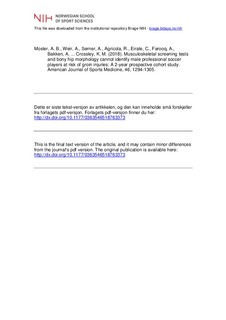| dc.description.abstract | Background: Musculoskeletal hip/groin screening tests are commonly performed to detect at-risk individuals. Bony hip morphology is considered a potential intrinsic risk factor but has not been examined prospectively. Purpose: To evaluate the association between intrinsic risk factors identified from musculoskeletal and radiographic screening tests and hip/groin injuries leading to time loss from training and/or match play in professional male soccer players. Study Design: Prospective cohort study; Level of evidence, 2. Methods: Male professional soccer players, aged ≥18 years, underwent screening specific for hip/groin pain during 2 consecutive seasons of the Qatar Stars League. The screening battery included pain provocation, range of motion, and strength tests as well as a hip radiographic examination. The radiographic examination included an anteroposterior pelvic view and 45° Dunn view, with bony hip morphology determined using quantitative methods. Time-loss (≥1 day) hip/groin injuries and individual player exposure (training and match play) were recorded prospectively, and injuries were categorized as adductor-related, inguinal-related, iliopsoas-related, pubic-related, or hip-related groin pain, or “other,” as recommended in the Doha agreement. We calculated hazard ratios (HRs) from univariate and multivariate Cox regression models to assess the relationship between potential risk factors and hip/groin injuries. Results: There were 438 players, completing 609 player seasons, and 113 hip/groin injuries that met the criteria for inclusion, with 85 injuries categorized as adductor-related. The proportion of players with bony morphological variants was the following: cam, 71%; pincer, 5%; and acetabular dysplasia, 13%. Previous hip/groin injuries (HR, 1.8; 95% CI, 1.2-2.7) and eccentric adduction strength were associated with the risk of hip/groin injuries. Higher (>1 SD above the mean) than normal eccentric adduction strength was associated with an increased risk for all hip/groin injuries (HR, 1.6; 95% CI, 1.0-2.5). Lower (<1 SD below the mean) than normal eccentric adduction strength was associated with an increased risk for adductor-related injuries (HR, 1.7; 95% CI, 1.0-3.0). No other musculoskeletal screening test or bony hip morphology variables were associated with the injury risk. Conclusion: Previous groin injuries and eccentric adduction strength were associated with the risk of groin injuries. However, these associations were not strong enough to identify an “at-risk” individual, and therefore, musculoskeletal screening tests were not useful to dictate individualized prevention strategies. Bony hip morphology was not associated with the risk of groin injuries. | nb_NO |
